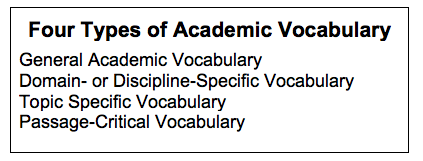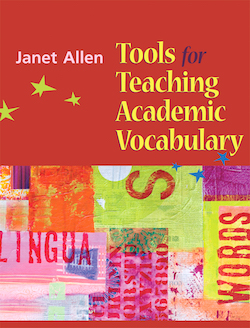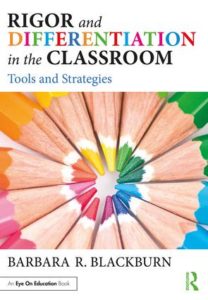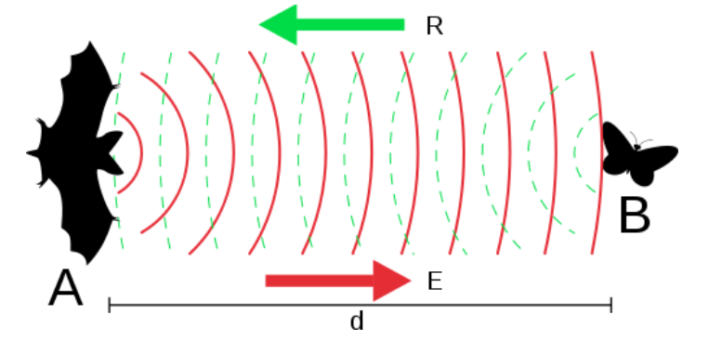3 Strategies for Teaching Academic Vocabulary
 By Barbara R. Blackburn
By Barbara R. Blackburn
Although we have always known the importance of teaching vocabulary, there has recently been a focus on academic vocabulary, especially vocabulary tiers, across the domains and content areas. Let’s take a look.
Tiers of Vocabulary
Tiers of Vocabulary were introduced by Isabel Beck and Margaret McKeown in 1987. As they describe them, Tier One words are acquired through everyday speech. These words are common and are typically taught at early grades or learned through everyday use around them.
Tier Two includes academic words that appear across all texts. They may change meaning due to use, and they present a challenge if experienced in text initially. Vocabulary instruction for these words typically adds to students’ understanding of the meaning.
Tier Three vocabulary is domain or content area specific. They are critical for building conceptual understanding in content, but they need to be learned via explicit instruction. These words are best taught when they are needed in the context of the lesson.
 Tier Two Words provide an opportunity for thorough vocabulary development. These should be words that you focus on in depth, since they will have applications not only in the specified text, but across other texts and areas of the curriculum.
Tier Two Words provide an opportunity for thorough vocabulary development. These should be words that you focus on in depth, since they will have applications not only in the specified text, but across other texts and areas of the curriculum.
Janet Allen’s Academic Vocabulary
In Tools for Teaching Academic Vocabulary (Stenhouse, 2014) Janet Allen organizes academic vocabulary by context. She explains there are four types of words: general academic words, domain- or discipline-specific terms, topic-specific vocabulary, and passage-critical words.
 First, there is general academic vocabulary, which is not discipline-specific. Students frequently see these words, such as analyze, synthesize, contrast, and restate. It’s important to provide detailed instruction with lots of practice, so that students are very familiar with them.
First, there is general academic vocabulary, which is not discipline-specific. Students frequently see these words, such as analyze, synthesize, contrast, and restate. It’s important to provide detailed instruction with lots of practice, so that students are very familiar with them.
 Next, she describes domain- or discipline-specific words, which are frequently used within a specific discipline, such as language arts, history, science or math. These words include terms such as foreshadowing, hypothesis, rational number, or aerobic exercise. Within the content area, these words should be reinforced regularly.
Next, she describes domain- or discipline-specific words, which are frequently used within a specific discipline, such as language arts, history, science or math. These words include terms such as foreshadowing, hypothesis, rational number, or aerobic exercise. Within the content area, these words should be reinforced regularly.
Third, there are topic-specific words. They are needed to understand a specific lesson or topic and are typically critical to an understanding of the concept. Direct instruction is usually necessary with these terms. Examples include Holocaust, biome, and impressionism.
Finally, passage-critical words are those that are necessary to understand a specific text. These words are crucial to comprehension of the passage. Particularly for specialized words, direct instruction is needed. Janet explains that in Sandra Markle’s book BATS: Biggest! Littlest!, sample passage-critical words include echolocation, horning, roost, and wingspan.
Whichever structure you use, thinking about the different types of vocabulary will help you teach words in a more meaningful way, as opposed to having students simply memorize definitions of random word lists.
Three Strategies for Teaching Academic Vocabulary
No matter which categories of academic vocabulary you use, it’s important to consider how to teach vocabulary. We’ll look at three strategies for vocabulary instruction: using visuals, playing games, and exploring multiple meaning words. A fourth popular technique – word walls – is highlighted in this resource at Teaching Tolerance.
1. Using Visuals to Enhance Understanding
Visuals can help students understand new concepts. I was in a social studies classroom in which the teacher was presenting geography terms such as equator, latitude, and longitude.
 She drew a circle on the board to illustrate the Earth, and then she wrote the word equator across the center. She wrote the word latitude horizontally from west to east where the latitude lines go across the Earth. Finally, she wrote the word longitude from north to south to clearly illustrate the meaning of the word. She provided visual context for her students as they encountered the terms for the first time.
She drew a circle on the board to illustrate the Earth, and then she wrote the word equator across the center. She wrote the word latitude horizontally from west to east where the latitude lines go across the Earth. Finally, she wrote the word longitude from north to south to clearly illustrate the meaning of the word. She provided visual context for her students as they encountered the terms for the first time.
I have used a graphic organizer to help students demonstrate their understanding in ways that required them to synthesize information about a term or concept and refine it down to the key points. Using a graphic organizer, students can discuss different elements of a particular vocabulary term.
Then my students could create their own graphic organizers to take notes about and demonstrate their understanding of vocabulary. I remember one student bringing me a graphic organizer she had completed about the Pythagorean Theorem. She had used right triangles to organize the information. Using visuals helps students connect their learning.
2. Playing Games
We need to experience new words and concepts multiple times in a variety of ways. Too often, we expect students to fully understand a word after they have read it one time. However, reading a word multiple times doesn’t ensure understanding either. Your students need to play with words in fun and different ways to help them learn.
James Good, a middle school drama teacher, points out that his students find the language of Shakespearean plays challenging. For key scenes, his students are broken into groups with five acting parts and a group director.
“Students identify difficult turns of phrase or specific vocabulary words and make their best educated guess as to meaning. They run lines with one another to improve pronunciation and dramatic reading. The director makes suggestions as to simple stage movements that can be done in the small space at the front of the room. The group discusses appropriate tone, body language, and facial expression. Concerning themselves with the dramatic aspects of presenting to the other three groups more or less forces them to make meaning. Each group takes a turn in a kind of ‘drama slam.’ They try to outdo the others and get delightfully hammy.”

3. Multiple Meaning Words
Particularly in specific content areas, it’s important to teach words that have multiple meanings. I was observing a student teacher in a science classroom one day, and he asked, “Does anyone know what grounded means?” It was his opening question for a lesson on electricity. Immediately one student shouted out, “That’s what happened to me last week when I made a C on my test!” Everyone laughed, but that’s an excellent example of a multiple meaning word. We need to specifically teach students the different meanings of these words. Janet Allen shares a chart that helps.

A Final Note
Understanding the various aspects of academic vocabulary, as well as strategies to support vocabulary instruction, is a key part of our overall instruction. Consider how you can use the types of vocabulary within your content area to improve your students’ comprehension.
 Barbara Blackburn was named one of the Top 30 Global Gurus in Education in 2017. A former teacher, school leader and university teacher educator, she is a best-selling author of 21 books including Rigor is Not a Four Letter Word and Rigor and Differentiation in the Classroom: Tools and Strategies (Routledge, 2018). A nationally recognized expert in the areas of rigor and motivation, she collaborates with schools and districts for professional development. Barbara can be reached through her website or her blog. Follow her on Twitter @BarbBlackburn.
Barbara Blackburn was named one of the Top 30 Global Gurus in Education in 2017. A former teacher, school leader and university teacher educator, she is a best-selling author of 21 books including Rigor is Not a Four Letter Word and Rigor and Differentiation in the Classroom: Tools and Strategies (Routledge, 2018). A nationally recognized expert in the areas of rigor and motivation, she collaborates with schools and districts for professional development. Barbara can be reached through her website or her blog. Follow her on Twitter @BarbBlackburn.



































